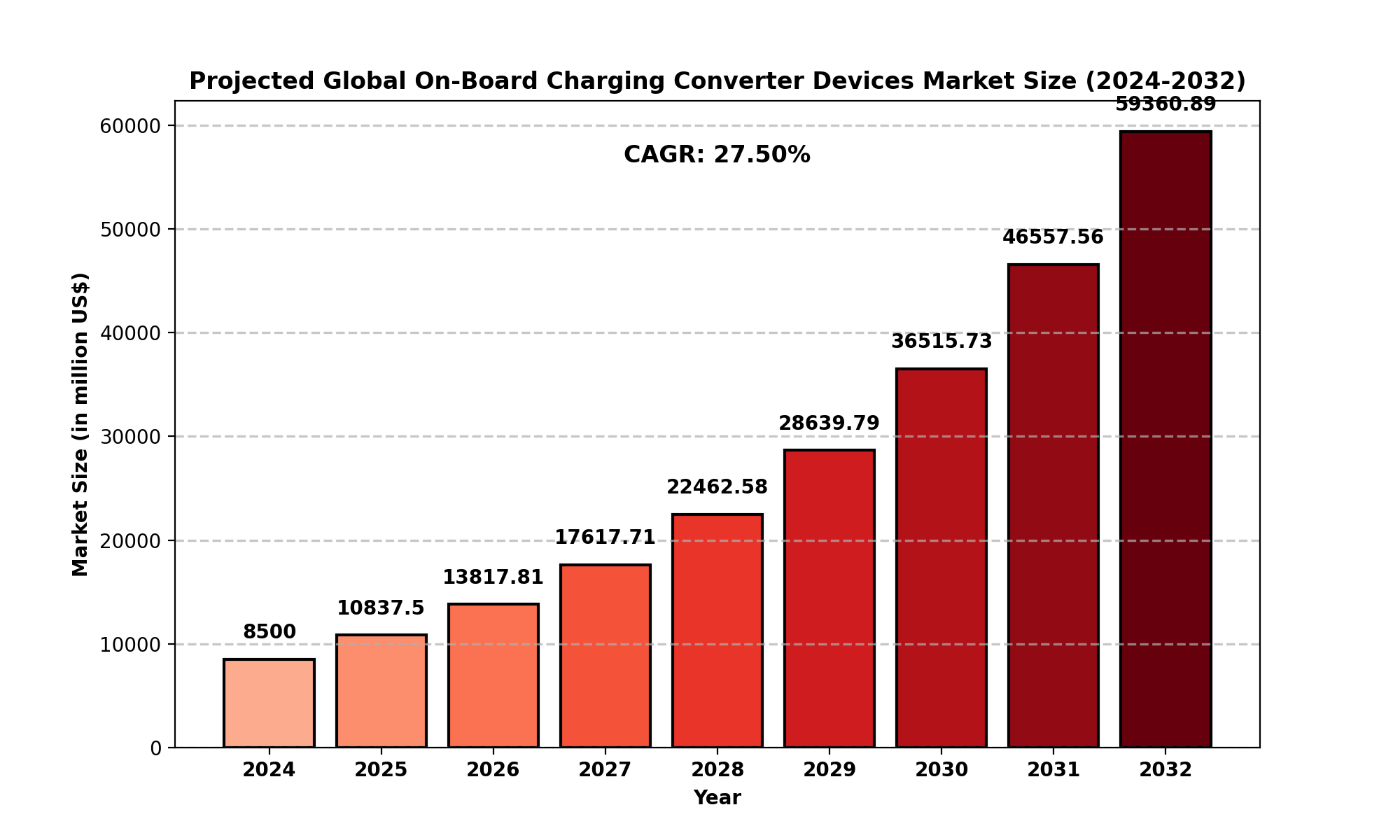TOP CATEGORY: Chemicals & Materials | Life Sciences | Banking & Finance | ICT Media

Download Report PDF Instantly
Report overview
The On-Board Charging Converter Devices Market refers to the segment of the automotive industry that deals with AC/DC converters installed within electric vehicles (EVs) and hybrid electric vehicles (HEVs). These devices enable the conversion of AC power from external charging sources into DC power to charge vehicle batteries efficiently. On-board charging converters are crucial for ensuring safe and rapid energy transfer, facilitating improved vehicle range, and supporting the growing infrastructure of electric mobility. These devices are widely used in passenger cars, commercial vehicles, and construction machinery, driving innovation in power electronics and vehicle electrification.
The global On-Board Charging Converter Devices Market was valued at USD 8,500 million in 2024 and is expected to grow at a CAGR of 27.50%, reaching USD 59,360.89 million by 2032.
North America accounted for USD 3,382.06 million in 2024, with a projected CAGR of 23.57% from 2025 to 2032.
The market's exponential growth is attributed to the increasing adoption of electric vehicles, rising environmental concerns, and government initiatives promoting EV infrastructure.
Historical data suggests a rapid shift from internal combustion engine (ICE) vehicles to electrified alternatives, boosting demand for on-board charging converters.

Drivers
Rising Adoption of Electric Vehicles (EVs): Global push towards sustainable transportation is propelling demand for efficient on-board charging solutions.
Government Incentives & Regulations: Subsidies, tax benefits, and stringent emissions regulations are fostering EV adoption.
Technological Advancements in Power Electronics: High-efficiency converters and smart charging solutions are being developed.
Infrastructure Expansion: Growth in EV charging stations is positively impacting market demand.
Restraints
High Initial Costs: EV charging technology is expensive, making adoption challenging in emerging economies.
Compatibility Issues: Different standards for AC/DC charging across regions may limit interoperability.
Limited Availability of Raw Materials: Dependence on semiconductors and rare-earth metals could impact production.
Opportunities
Integration of Wireless Charging: Innovations in inductive charging present new growth avenues.
Growing Fleet Electrification: Commercial and logistics fleets shifting to EVs will expand market potential.
Expansion in Emerging Markets: Developing nations are increasingly investing in EV technology and infrastructure.
Challenges
Grid Load Management: Increased EV adoption requires substantial power grid enhancements.
Cybersecurity Concerns: With growing connectivity in EVs, security vulnerabilities in on-board chargers need addressing.
North America
The U.S. and Canada are leading the market due to strong EV adoption.
Government policies such as tax credits and fuel efficiency regulations drive demand.
Europe
Germany, France, and the UK dominate the region’s market, backed by stringent emissions regulations and aggressive EV expansion plans.
High EV penetration and charging infrastructure investments fuel market growth.
Asia-Pacific
China leads global EV sales, making it the largest market for on-board charging converters.
Japan, South Korea, and India are investing heavily in EV technology and charging networks.
South America & Middle East-Africa
Slower adoption rates but rising investments in urban electrification and sustainable transport solutions.
Brazil and South Africa show potential for future market expansion.
Key Companies
Infineon – Leading semiconductor manufacturer, offering advanced power electronics.
Delta Electronics – Specializes in high-efficiency power conversion solutions.
TDK Corporation – Develops electronic components crucial for charging technologies.
Delphi – Innovates in automotive electrification and power management.
Continental – Supplies integrated EV powertrain solutions.
XP Power – Focuses on high-performance power supplies for electric mobility.
Toyota Industries, Denso, Hitachi Automotive Systems, Mobis, Keboda – Major players advancing on-board charging solutions.
AC/DC Converter – Converts alternating current to direct current for battery charging.
DC-DC Converter – Ensures optimal power transfer within EV systems.
Car – Passenger EVs, the largest segment in the market.
Truck – Electrification of heavy-duty vehicles is gaining traction.
Commercial Vehicles – Logistics and public transport adopting EV fleets.
Others – Specialty vehicles, construction, and industrial electric machinery.
North America: USA, Canada, Mexico
Europe: Germany, UK, France, Russia, Italy, Rest of Europe
Asia-Pacific: China, Japan, South Korea, India, Southeast Asia, Rest of Asia-Pacific
South America: Brazil, Argentina, Colombia, Rest of South America
Middle East & Africa: Saudi Arabia, UAE, Egypt, Nigeria, South Africa, Rest of MEA
What is the current market size of the On-Board Charging Converter Devices market?
The market was valued at USD 8,500 million in 2024 and is projected to grow to USD 75,685.13 million by 2032, with a CAGR of 27.50%.
Which are the key companies operating in the On-Board Charging Converter Devices market?
Major players include Infineon, Delta Electronics, TDK Corporation, Delphi, Continental, XP Power, Toyota Industries, Denso, Hitachi Automotive Systems, Mobis, and Keboda.
What are the key growth drivers in the On-Board Charging Converter Devices market?
Key drivers include rising EV adoption, government incentives, technological advancements in power electronics, and expanding EV charging infrastructure.
Which regions dominate the On-Board Charging Converter Devices market?
Asia-Pacific (China, Japan, South Korea), North America (USA, Canada), and Europe (Germany, UK, France) lead the market.
What are the emerging trends in the On-Board Charging Converter Devices market?
Emerging trends include wireless charging, vehicle-to-grid (V2G) integration, fast-charging technologies, and AI-driven power management.
This report serves as an essential guide for industry players, investors, researchers, consultants, and business strategists looking to navigate the evolving On-Board Charging Converter Devices Market.
Industry drivers, restraints, and opportunities covered in the study
Neutral perspective on the market performance
Recent industry trends and developments
Competitive landscape & strategies of key players
Potential & niche segments and regions exhibiting promising growth covered
Historical, current, and projected market size, in terms of value
In-depth analysis of the On-Board Charging Converter Devices Market
Overview of the regional outlook of the On-Board Charging Converter Devices Market:
Access to date statistics compiled by our researchers. These provide you with historical and forecast data, which is analyzed to tell you why your market is set to change
This enables you to anticipate market changes to remain ahead of your competitors
You will be able to copy data from the Excel spreadsheet straight into your marketing plans, business presentations, or other strategic documents
The concise analysis, clear graph, and table format will enable you to pinpoint the information you require quickly
Provision of market value data for each segment and sub-segment
Indicates the region and segment that is expected to witness the fastest growth as well as to dominate the market
Analysis by geography highlighting the consumption of the product/service in the region as well as indicating the factors that are affecting the market within each region
Competitive landscape which incorporates the market ranking of the major players, along with new service/product launches, partnerships, business expansions, and acquisitions in the past five years of companies profiled
Extensive company profiles comprising of company overview, company insights, product benchmarking, and SWOT analysis for the major market players
The current as well as the future market outlook of the industry concerning recent developments which involve growth opportunities and drivers as well as challenges and restraints of both emerging as well as developed regions
Includes in-depth analysis of the market from various perspectives through Porter